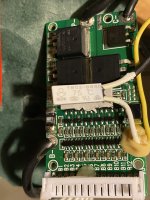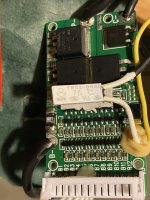pistolpete1776
100 µW
Hi - newbie here to the forum. I did search my issue and definitely got smarter, but still need some guidance.
My GF has a Blix ebike and she didn't charge the battery at all this past winter. The battery does have an on/off switch and it was left off (which I guess disconnects the BMS so it doesn't drain). The battery was kept inside, disconnected from the bike. The battery also has an LED charge indicator.
The battery is a 48v 14ah 13s4P with Samsung 18650 cells.
The problem is that the battery is completely non-responsive. At the power output terminals I get 0.9v. Nothing on the LED charge indictor.
Opening the battery case, I inspected everything. All wires well connected. No sign of burns or other heat issues.
I reset the BMS using the common online instructions - disconnect balancing harness from BMS, plug in charger, reconnect harness. No help. Is there another way to reset the BMS?
I tested the battery pack and each cell. Across the entire battery pack I get 54.1v. I get the same 54.1v at the charging terminal. I tested each of the 13 cells, both on the pack and at the balance wire harness, and I get 4.2v for most of them and 4.1 for a few. With the balance wire harness disconnected from the BMS, I get 33.1v at the power output terminals. When I reconnect the harness it goes back to 0.9v.
So I'm thinking the battery pack is good and the BMS is bad - does that sound right? Or is there something else I should be trying to revive this seemingly good battery?
If replacing the BMS, what amperage should I use? The motor is 500w and I suspect the current BMS is 15a. Attached are pics of the current BMS. It looks like they piggybacked the on/off switch on the thermal protection lead.
Thanks for the help!
My GF has a Blix ebike and she didn't charge the battery at all this past winter. The battery does have an on/off switch and it was left off (which I guess disconnects the BMS so it doesn't drain). The battery was kept inside, disconnected from the bike. The battery also has an LED charge indicator.
The battery is a 48v 14ah 13s4P with Samsung 18650 cells.
The problem is that the battery is completely non-responsive. At the power output terminals I get 0.9v. Nothing on the LED charge indictor.
Opening the battery case, I inspected everything. All wires well connected. No sign of burns or other heat issues.
I reset the BMS using the common online instructions - disconnect balancing harness from BMS, plug in charger, reconnect harness. No help. Is there another way to reset the BMS?
I tested the battery pack and each cell. Across the entire battery pack I get 54.1v. I get the same 54.1v at the charging terminal. I tested each of the 13 cells, both on the pack and at the balance wire harness, and I get 4.2v for most of them and 4.1 for a few. With the balance wire harness disconnected from the BMS, I get 33.1v at the power output terminals. When I reconnect the harness it goes back to 0.9v.
So I'm thinking the battery pack is good and the BMS is bad - does that sound right? Or is there something else I should be trying to revive this seemingly good battery?
If replacing the BMS, what amperage should I use? The motor is 500w and I suspect the current BMS is 15a. Attached are pics of the current BMS. It looks like they piggybacked the on/off switch on the thermal protection lead.
Thanks for the help!
Attachments
Last edited:




